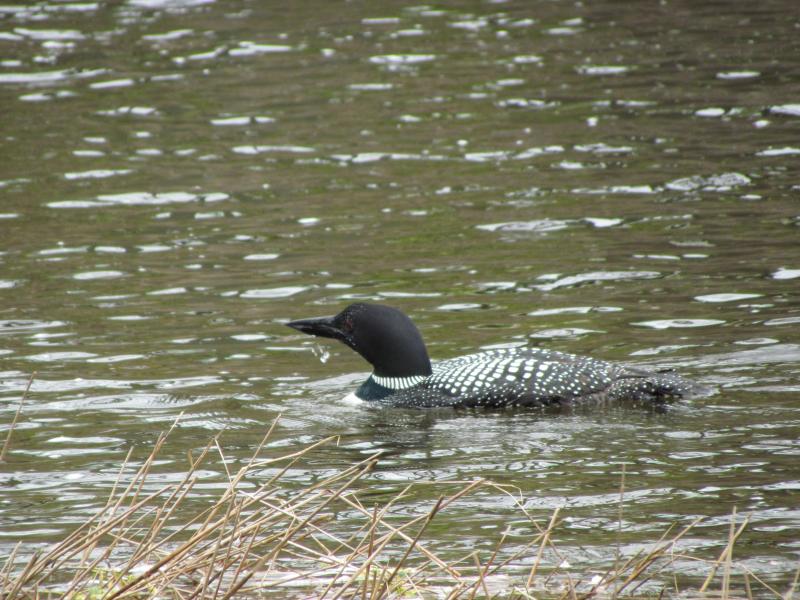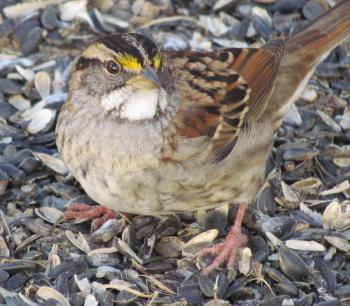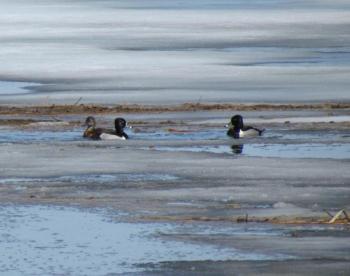After the wild swings of temperature that we all endured this winter, it is hard to imagine that spring could really be in the cards. But there is no stopping the seasonal changes that come about from Earth’s rotation around the sun. The days are getting longer and, on average, slightly warmer day by day. Rain is falling more regularly instead of snow, and the earliest migrant birds are returning.
A number of times over the last 10 days, we have seen turkey vultures, their silver-toned underwings contrasting with the rest of their solid black plumage, as they glided by with wings held in a shallow V-shape. Some of the days when we saw them would have been hard to consider very spring-like even for the eternally optimistic.
But there they were.
Red-winged blackbirds, always one of the earliest spring arrivals, have been spotted by dozens of birders from Bangor south over the last three weeks. And an American woodcock was reported from Monhegan just this week.
Spring is coming, and the new arrivals will begin to be a daily occurrence.
At this time of year, we are thinking especially of wonderful places even farther north where spring bird arrivals are still some weeks or even months away. These are the places that so many of the birds that spent their winters here, or that will pass through here in the coming weeks, are headed to in order to raise their young. Thanks to Indigenous governments, a great many of these special places are in the midst of turning into new types of protected areas where no industrial activity will ever disturb them.
Here are a few of the birds that spend winters here or migrate through and the amazing places that some of them may be migrating to for the summer.
Common Loon
While the common loon is a signature summer bird of Maine’s many beautiful lakes, the truth is that Maine is actually at the southernmost extent of the species’ breeding range, which extends across Canada through the Boreal Forest to the Arctic. In winter, common loons from Canada and Alaska come south to winter along the Atlantic and Pacific Coasts of the U.S. south to Mexico. We have lots of them along our Maine coast all winter. Beginning in March and April, those northern nesting loons begin heading back home to places like the Seal River Watershed of northern Manitoba. The 12 million- acre watershed contains more than a thousand lakes and has been proposed as a new Indigenous Protected Area by the Seal River Watershed Alliance—a group of Indigenous governments and communities in the region.
White-throated Sparrow
A few white-throated sparrows spend the winter here in Maine (we’ve had a few all winter at our backyard feeder) but the largest numbers occur across the southeastern U.S. with a few that winter along the Pacific Coast. The species is a common bird here in Maine in summer, where the sounds of its sweet whistled “Old-Sam-Peabody-Peabody-Peabody” song is a familiar refrain. But its breeding range extends north from here across most of Canada south of the Arctic. One of the special places in the Boreal Forest region that supports large numbers of white-throated sparrows is the North French River Watershed, a more than one million acre proposed new Indigenous Protected Area near the southern extent of James Bay—an initiative being led by the Moose Cree First Nation.
Ring-necked Duck
Occasionally a handful of these handsome peaky-headed ducks will spend the winter here in Maine but most occur in the southern U.S., with scattered smaller numbers through Mexico, Central America, and the Caribbean. We have even seen a few in past years on Aruba, just off the coast of South America. Ring-necks are also one of the early duck migrants with new arrivals showing up in Maine in late February and continuing through March and April. Their breeding range extends from the northeastern U.S. across the millions of acres of wetlands of the Boreal Forest region of Canada and even into eastern Alaska. One of their important nesting areas is in the Saskatchewan River Delta of Saskatchewan and Manitoba, one of the largest inland freshwater deltas in the world and an important waterfowl breeding area including for ring-necked ducks. Protection of the more than 2 million-acre delta is being led by the Cumberland House Cree Nation.
As the birds of spring make their grand northward migration, we hope all of you will join with us in thinking of the special places they are headed that are being protected and stewarded by the Indigenous governments and peoples across one of the largest and most intact forest ecosystems left on the planet—the Boreal Forest.
Jeffrey V. Wells, Ph.D., is a Fellow of the Cornell Lab of Ornithology and Vice President of Boreal Conservation for National Audubon. Dr. Wells is one of the nation's leading bird experts and conservation biologists and author of the “Birder’s Conservation Handbook.” His grandfather, the late John Chase, was a columnist for the Boothbay Register for many years. Allison Childs Wells, formerly of the Cornell Lab of Ornithology, is a senior director at the Natural Resources Council of Maine, a nonprofit membership organization working statewide to protect the nature of Maine. Both are widely published natural history writers and are the authors of the popular books, “Maine’s Favorite Birds” (Tilbury House) and “Birds of Aruba, Bonaire, and Curaçao: A Site and Field Guide,” (Cornell University Press).

































